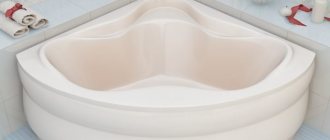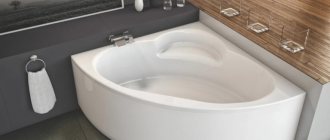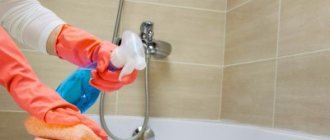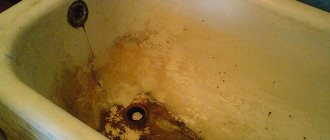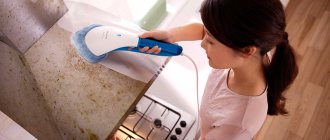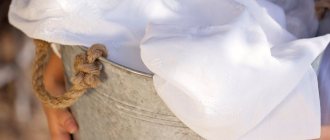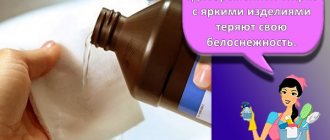Mechanical or chemical impact leads to damage to the surface of the bath. Enamel and acrylic lose their smoothness and whiteness, and moisture, dirt and mold penetrate into microscratches.
Dark plaque can occur even with proper care, so owners are faced with the question of how to whiten a bathtub at home without increasing damage to the material.
Why does the bathroom get dirty?
Regardless of the type and composition of the snow-white base, the reasons for contamination of the paint surface can be both natural hair products and chemicals for body care, of which there are a very large number in modern cosmetics. Often ordinary tap water with the salts and chlorine it contains also acts as pollutants.
There are two ways to lighten a bathtub - by removing plaque or bleaching it.
To cope with each of them, you need to have on hand the most common housewife tool - washing sponges and working solutions. Most often, the necessary product can be found at hand; there are also professional materials sold in specialized stores.
Before you start cleaning, check what material the bathtub is made of.
Before you clean the stains, it is useful to have an idea of what they actually are.
Removing soap scum
Soap foam, combining with the minerals that make up the water, forms persistent complexes that are difficult to remove when drying. By washing off the foamy sediment before it hardens, you will simplify the task of cleaning your bathroom and make it snow-white. Such plaque is more often formed when using solid soap due to the talc contained, which binds fat and calcium ions. You can prevent soap scum in your bathtub if you use liquid rather than solid soap.
If foam stones do appear in your bathtub, you can make it snow-white using a home remedy:
- citric acid crystals (10-15 g);
- hot water (200-250 ml).
Pour the lemon into a container with hot water. Soak a washcloth in it and spread the liquid over the bath in a thin layer. Instead of a sponge, you can use a spray bottle.
Wait a quarter of an hour and rinse off. Lemon solution destroys strong rocky joints and makes plumbing fixtures shine.
Traditional ways to clean baths
Types of bath contamination
All visible pollution is usually divided according to the nature of the reasons that caused its appearance.
A clogged drain will negate all the effort spent on cleaning the bathtub. Hard water. A high concentration of salts in the water used for bathing has the most negative effect on the acrylic or enamel of the bathtub. After them, the surface ceases to be glossy and gradually turns into a loose and unsightly layer. The pores that form on the surface actually begin to trap dirt and remnants of chemicals used in bathing on the surface.
Note! Too hard water is harmful not only to the bathroom coating, but also to human skin.
Over time, the enamel of the bathtub becomes covered with plaque, rusty spots and begins to darken.
High chlorine content in water. Modern water treatment plants continue to use chlorine as their primary method of combating harmful bacteria and microorganisms. Without completely dissolving in water, such compounds linger on the snow-white surface of the bath, destroying it. Elements made of liquid acrylic and plastic suffer especially greatly from such impurities.
In production, bathtubs are made from a material that does not change its color over time.
Rust or yellowing. Many urban communications of modern cities are still in a deplorable state, and rust appears from time to time as one of the polluting factors in the bathroom. It is especially dangerous if the enamel has previously been damaged by other substances, then the rust actually eats into the paint layer, forming unsightly orange smudges.
Yellow plaque initially manifests itself in the area of the drain hole.
Also, if the base of the bathtub is made of steel or cast iron, water can penetrate through microcracks in the enamel layer, coming into contact with the metal and causing oxidative reactions. They will also result in unsightly rust stains.
The main reason for the appearance of stains is the quality of the supplied water.
Soap deposits. It is recommended to wash off all remaining dirt from the surface of the bath after each use. Otherwise, over time, plaque will certainly begin to form on the acrylic or enamel of the bathtub. And because of its alkaline composition, soap will only speed up this process.
The most effective and best remedy is the one prepared with your own hands at home.
The use of dyes in household chemicals. Such dyes are certainly present in all hair products, shower gels, shampoos and even liquid soap. Accumulating over time, they turn the snow-white surface into an obscene appearance.
Note! Many folk remedies have the greatest coloring effect on the surface of the bath - decoctions of oak bark, onion peels, turmeric, walnuts and saffron.
Special cleaning products
Special compositions of cleaning products are specially developed to achieve the best effect and guarantee at least a result no worse than traditional ones. However, their improper use can cause more harm, because all such solutions use an aggressive chemical base, which may well cause negative consequences.
SIF - necessary for whitening the bath.
Therefore, before you start using any professional product, you must carefully study its instructions and strictly follow them.
The most well-known and effective means, which can also be purchased at almost any department store, are:
- Acrilan.
- Frosch.
- Unicum.
- Cif.
There are many white bath products available today.
The above products are available in the form of gels and foams for cleaning the bathtub, however, for severe stubborn dirt, it is recommended to use compositions such as Cilit Bang or Pemolux. Remember that they are not suitable for preventive care due to their high chemical activity in the case of Cilit,
Ideally, the bathroom should sparkle with tiles and snow-white fixtures.
Pemolux is a powder that is not recommended for use on minor stains due to the risk of damaging the glossy surface of the bathtub.
Removing traces of repairs
Most building materials pollute and also damage the enamel (polymer, stone) of the bathroom. In order not to think about how to make a bathtub snow-white after construction work, take care that it does not get dirty during the reconstruction of the room. To do this, place sheets of cardboard on the bottom of the bowl and cover with thick film on top.
Special products for removing traces of repairs
If during the renovation work the bathtub nevertheless becomes dirty and has lost its original snow-white appearance, purchase an industrial solvent for removing cement (Prosept Cement Cleaner, Unicum). Acids are added to such liquids, so they cannot be used for plastic baths. Wipe off paint splashes that get on plumbing fixtures with fresh paint before they dry. Doing this later will be problematic.
Effective folk remedies for cleaning
In addition to a wide selection of professional products, there are also a number of folk recipes that recommend using commonly available table ingredients such as vinegar, soda or citric acid as the main materials for cleaning the bathtub.
Time passes and the enamel of the bathtub begins to darken, becoming covered with stains and rusty stains.
We will talk about these and some other equally effective means further.
Vinegar
Regular table vinegar is an excellent tool not only for cleaning, but also for disinfecting the surface of the bathtub. Moreover, to obtain an acceptable effect, a 9% solution is quite enough; it is not at all necessary to take a concentrated essence.
To whiten a bathtub, you first need to rinse it.
With its help, you can remove not only salt or lime deposits from the surface, but also disinfect against fungus and other harmful microorganisms. When using this product, the following methods are used.
- Vinegar bath. Add a liter of vinegar to a whole bath of warm water and leave the resulting solution for 6-12 hours.
- Vinegar lotions. As the name implies, pour a little 9% solution onto a small piece of gauze, cotton wool or paper and leave for 6-8 hours. This way it is possible to remove both rust and strong alkaline deposits.
- A mixture of baking soda and vinegar with bleach. Due to its high toxicity, we recommend cleaning with this solution wearing protective gloves, goggles and a mask. And because of its high aggressiveness, this method is suitable for old stains that could not be removed with more gentle recipes. First, the bath is pre-washed with running water and treated with a mixture of salt, water and soda. After 10 minutes, pour a mixture of table vinegar and bleach in equal parts over the powder layer. After another 30 minutes, add a little soda to enhance the reaction and wash off the remaining product from the surface with a household sponge. After another 5-7 minutes, the process can be considered complete; the bath can be used only after thoroughly rinsing the surface with water.
Note! For this method, it is recommended to cover the surface of the bath with a layer of film to prevent toxic vinegar from evaporating into the room.
Use different products to whiten your bathtub.
Soda
Baking soda itself works well as a mild cleaning powder, which means it can be used to clean bathtub enamel with minor stains.
Baking soda is a good stain remover for white items.
A better effect can be achieved if you use it in a mixture with soap or acids, for example, vinegar. However, it is important to observe the time (on average no more than 30 minutes) for keeping such a composition on the paint surface.
Lemon acid
Citric acid, which can be found either in the juice of fresh lemons or in powder dissolved in water, can remove the following types of contaminants:
- lime;
- rust;
- yellowing of the enamel.
Citric acid is ideal for cast iron bathtubs.
Lemon juice is used in a 1:1 ratio with water; it is better to give such liquid time to begin to have an effective effect - usually 10 minutes is enough. If you decide to use citric acid in powder, add 2 tablespoons of the substance to a glass of water and use it mainly with pre-soaking.
You can whiten a cast iron bathtub at home using homemade mixtures.
Oxalic acid
This remedy, although classified as folk, is often used in professional cleaning. Acid should be used with extreme caution - a concentration higher than the recommended 5% can give a much more negative result than benefit.
Oxalic acid is suitable for simple stains.
Leave the acid on the surface of the stain for 1-2 hours, and then remove it with liquid soap.
Useful tips
To remove yellowness and further maintain the cleanliness of the font, it is important to remember the following useful recommendations:
After each use, rinse the bathtub with warm water, then wipe dry with a soft cloth.- When using any plumbing product, it is advisable to wear gloves to protect your skin from irritation.
- Before removing yellow stains using household chemicals, you need to turn on the forced exhaust in the bathroom.
- The final stage of any cleansing with a special product is rinsing the bath with water and wiping dry with a napkin.
- You should not place metal cans and bottles on the sides of the bathtub, as they may leave rust marks.
- It is necessary to keep the faucet in good condition, since constantly dripping or flowing water leaves a persistent smudge.
All the most important and useful information about cleaning the bathroom is collected in this section of the site.
Cleaning an acrylic bathtub
When cleaning this type of bathtub, it is strictly forbidden to use substances that can dissolve plastic. Therefore, we carefully read the instructions for the professional product, and also do not deviate from the recommendations for folk remedies.
Acrylic coating is a relatively new material that has quickly gained popularity.
It is best to clean an acrylic bathtub with a weakly acidic solution - vinegar, oxalic acid, avoiding prolonged exposure to the surface. The use of powders is prohibited; they can cause great harm to the surface.
Modern cast iron and metal bathtubs may also have an acrylic coating.
Before bleaching an acrylic bathtub at home, it is recommended to first test the selected product in an inconspicuous place of the bathtub, for example, a side bend. And if such a test does not show any negative results, work can continue.
Daily prevention
Basic care is very important; only regular cleaning will allow you to enjoy your snow-white bathtub for as long as possible. If you want to remove small rust stains and give it real whiteness, you can use this method:
- pour a full bath of water, add 200 ml of vinegar essence and let stand for 3 hours. Then, drain the water and rinse everything with clean, running water;
- For owners of an acrylic bathtub, you need to use the following composition: apply a mixture of salt and heated vinegar to rust stains and rinse with water. A mixture of salt and turpentine also works well.
The main condition for long-lasting whiteness is cleaning after each use and wiping dry with a cloth.
Whitening a cast iron bathtub
Cast iron is covered with an enamel layer, which requires cleaning over time. Here you can use almost any product, because enamels for such baths are quite durable. The question of how to whiten a cast-iron bathtub at home is not as complicated as it seems.
A cast iron bathtub is famous for its ability to maintain water temperature for a long time.
A combination of several products is best suited - soda with vinegar, oxalic acid, special products for enamel surfaces, mentioned earlier.
How to clean a heavily stained bathtub
If cleaning work is planned to be carried out on a heavily soiled bath, it should be divided into several separate stages. The first step is to remove traces of rust, after which you can proceed to the treatment of alkaline deposits.
If you want to achieve really good results, you will have to perform a whole cycle of washing operations.
Everyone can decide for themselves how to whiten a bath; you just need to carefully re-read the review of the most effective means offered above.
How to avoid mistakes
Most often, errors arise due to non-compliance with the holding time of cleaning agents and solutions on the surface. Therefore, for professional liquids, we carefully read the instructions for their use, and for equally effective folk remedies, we use the recommendations of this material.
Enamel loses its whiteness faster than other materials and becomes dull and gray.
It is also worth remembering that enamel and acrylic are materials with different properties and must be cleaned in accordance with the recommendations.
What can't be used?
When cleaning the bathtub, you should remember that not all products and tools are universal. Some of them can cause damage to enamel, acrylic or metal surfaces.
To avoid damaging your plumbing when removing yellow stains, it is recommended to exclude:
- Steel wool and brushes. Hard products leave scratches, as a result of which the bathtub will require cosmetic repairs.
- Strong acids and alkalis. These reagents can ruin acrylic and enamel and thin the walls of a metal bath.
- Products intended for cleaning toilets. Such gels contain aggressive components that can damage the bathtub coating.
How often do you need to clean the bathtub?
In modern plumbing conditions, it is recommended to rinse it clean every time after taking a bath, and wash it with cleaning powder at least twice a month. Of course, if the bath is used more intensively, prevention should also be carried out more often.
If folk remedies are not suitable for some reason, you can go to the store and purchase specialized household chemicals.
But for a family of three, one cleaning every two weeks will provide the bathtub cover with a long period of brilliant (in every sense) service.
How to care for your bathroom
The main methods of care include the already mentioned rinsing after each use of water procedures, as well as maintaining its surface in its original form. And even if pollution appears, you can deal with it in just a few steps, thanks to the information from this article.
It is simply necessary to bleach the bathtub, because this particular part of the apartment is one of the signs of a good housewife or owner.
Maintaining a bathtub in its original form is not as difficult as it seems, and if you suddenly need to whiten its surface, the recommendations of this material will come in handy.
